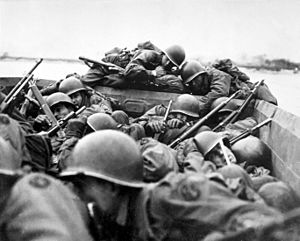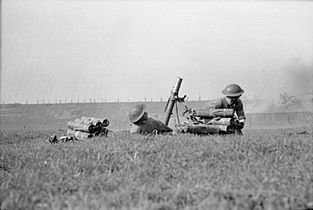Operation Plunder facts for kids
Quick facts for kids Operation Plunder |
|||||||
|---|---|---|---|---|---|---|---|
| Part of the Western Allied invasion of Germany in the Western Front of the European theatre of World War II | |||||||
 U.S. 89th Division crossing the Rhine under fire |
|||||||
|
|||||||
| Belligerents | |||||||
| Commanders and leaders | |||||||
|
|||||||
| Units involved | |||||||
|
|
||||||
| Strength | |||||||
|
|
||||||
| Casualties and losses | |||||||
|
16,000 captured | ||||||
Operation Plunder was a major military plan during World War II. It happened on the night of March 23, 1945. The main goal was for Allied soldiers to cross the Rhine River into Germany. This river crossing was a huge step in the final push into Germany.
The 21st Army Group, led by Bernard Montgomery, was in charge. Two main armies took part: the British Second Army and the United States Ninth Army. They crossed the Rhine at different points, including Rees and Wesel.
Another important part of the plan was Operation Varsity. This involved airborne forces (paratroopers and glider troops) landing on the east side of the Rhine. Their job was to help the ground troops by disrupting enemy communications. There was also a smaller mission called Operation Archway by the Special Air Service.
To keep the operation a secret, a huge smoke screen was put up starting March 16. This hid the preparations, like building roads and moving 36 Royal Navy landing craft.
Contents
The Battle Begins
Heavy Bombardment
The operation started with a massive attack. Four thousand Allied guns fired for four hours straight. British bombers also attacked the city of Wesel during the day and night of March 23, 1945. This heavy bombing helped clear the way for the troops.
Building Bridges
On the night of March 23, American engineers quickly built special rafts. These rafts helped troops cross the Rhine River south of Wesel. The next morning, they started building a floating bridge.
It was an amazing feat of engineering. In just over six hours, they built a bridge more than 1,152 feet long. This was a record for a bridge of that size. Many trucks were needed to bring all the bridge parts to the river.
First Troops Across
Three main Allied groups led the first attack. The British 79th Armoured Division played a key role. They used special armored vehicles called "Hobart's Funnies". These vehicles were designed for tough conditions.
One type of vehicle was the "Buffalo," an armored transporter that could cross soft and flooded ground. These Buffalos carried the first infantry soldiers across the river.
The first British troops to cross were from the 51st (Highland) Division. They crossed near Rees at 9:00 PM on March 23. The 15th (Scottish) Infantry Division followed a few hours later. At first, there wasn't much resistance. But soon, German machine guns began to fire. Sadly, the commander of the 51st Division, Major-General Tom Rennie, was killed by mortar fire.
American Crossings
The U.S. 30th Infantry Division crossed south of Wesel. The intense artillery and air attacks had weakened the German defenses there. So, American soldiers faced very little opposition. The U.S. 79th Infantry Division also crossed. American casualties were very low.
Meanwhile, the British troops faced stronger German resistance. There were even some armored counter-attacks. But the crossings continued, and tanks and other heavy equipment were brought over. By the evening of March 24, American forces had a full bridge built across the Rhine.
Airborne Support
Operation Varsity began at 10:00 AM on March 24. Its goal was to confuse and disrupt German communications. Despite strong resistance, the airborne troops made good progress. They fought off German counterattacks. By the afternoon, the airborne divisions met up with the 15th (Scottish) Division.
Securing the Bridgehead
Fierce German resistance continued in some areas, especially around Bienen, north of Rees. The 9th Canadian Infantry Brigade had to help relieve the British troops there. However, the Allies had a strong advantage in numbers and equipment.
By March 27, just four days after the operation began, the Allied forces had secured a large area. Their bridgehead was about 35 miles wide and 20 miles deep. This meant they had a firm foothold on the east bank of the Rhine.
-
British Commandos moving through the destroyed areas of Wesel.
-
A 3-inch mortar of the 8th Royal Scots under enemy fire during the Rhine crossing on March 24, 1945.
After the Battle
German Forces Retreat
The German forces opposing Operation Plunder were the German 1st Parachute Army. This army was already very weak from earlier battles. They could not stop the strong Allied attack.
The German army had to retreat northeast towards Hamburg and Bremen. This created a large gap in their defenses. The German leaders knew the situation was very bad. They had few soldiers, no reserves, weak artillery, and almost no air support or tanks.
Even though they were ordered to hold their ground, the German generals decided to withdraw. They wanted to avoid losing more soldiers. Within a week of Operation Plunder, the Allies had captured 30,000 German prisoners of war.
Winston Churchill's Visit

British Prime Minister Winston Churchill was at Field Marshal Montgomery's headquarters just before Operation Plunder began. He even watched the Operation Varsity airborne landings on March 24.
The next day, Churchill visited General Dwight D. Eisenhower's headquarters. After a meeting, Churchill, Montgomery, and some American commanders took a small landing craft. They landed on the German side of the Rhine for about 30 minutes, even though it was enemy territory. They were not challenged. They also visited a destroyed railway bridge before leaving when German artillery seemed to target them.
Other Rhine Crossings
Operation Plunder was planned as the main crossing of the Rhine. However, two other crossings happened earlier.
On March 7, American troops unexpectedly captured the Ludendorff Bridge during the Battle of Remagen. Over the next 10 days, many troops crossed the Rhine using this bridge.
Then, on March 22, General George S. Patton's Third Army also crossed the Rhine at Nierstein. This was done to draw away German forces from the main Operation Plunder area.
In Culture
- "Crossing the Rhine", Episode 8 of The Lost Evidence, The History Channel, UK, 2004.
- Heinz Bosch, Wilhelm Haas: Der Krieg am Niederrhein, Kreis Kleve, 1976 (German).
See Also
- Ludendorff Bridge, the bridge at Remagen




